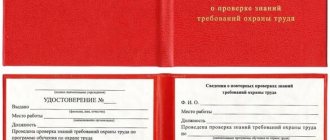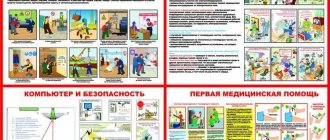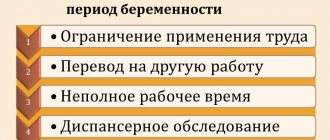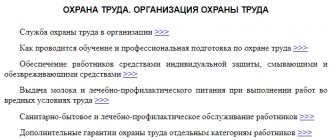Why do we need a labor safety regulation?
In accordance with paragraph. 22 hours 2 tbsp. 212 of the Labor Code of the Russian Federation, each company must draw up and approve labor safety rules. These rules, in cases established by law, should be agreed upon with the trade union committee on the basis of Art. 372 Labor Code of the Russian Federation. These rules also include a local regulatory act - the regulations on labor protection (hereinafter referred to as the Regulations). This document must contain a list of measures that the employer is obliged to implement in order to ensure safe and comfortable working conditions for its employees.
Thus, the Regulations reflect the following types of events:
- organizational;
- legal;
- technical;
- social;
- rehabilitation;
- preventive.
The Labor Safety Regulations specify:
- responsibilities of the director for ensuring labor safety (hereinafter - OSH) at the enterprise;
- the employee responsible for ensuring occupational safety at the enterprise, his responsibilities and work procedures;
- the procedure for planning and carrying out activities within the framework of providing occupational safety;
- rights of workers in the field of occupational safety;
- the procedure for monitoring compliance with occupational safety standards and compliance with safety rules;
- responsibility for failure to fulfill obligations and regulatory requirements for ensuring occupational safety at the enterprise;
- the procedure for approving the composition of the commission for assessing working conditions;
- the procedure for forming a budget for occupational safety, items of planned expenses and sources for their financing.
The same document may contain information about the organization of the occupational safety service, as well as information about training of employees. But usually, for a comprehensive disclosure of the issues raised above, separate provisions and instructions are developed.
Read about how OT instructions are drawn up in this article .
The employer can indicate in the Regulations and then annually implement any measures that improve the working conditions of employees. But only those mentioned in the Standard List of Measures to Improve Conditions and Labor Protection and Reduce Profit Risks, approved by Order of the Ministry of Health and Social Development dated March 1, 2012 No. 181n, can be included in the expenses for reducing taxable profit.
How to organize labor protection at an enterprise was explained by T. M. Zhigastova, 3rd Class Actual State Advisor of the Russian Federation. Get trial access to ConsultantPlus and study the official’s point of view for free.
Labor protection in the interpretation of Russian legislation
Labor safety standards and requirements must be observed in any organization, regardless of its form of ownership and number of employees. Work safety standards are prescribed in the relevant state rules and regulations, federal laws and other legal acts.
The work of the state in the field of labor protection is based on the synchronized actions of all its participants - government authorities at the federal and local levels, employers, trade unions, etc.
In addition, the constituent entities of the Russian Federation regularly develop special programs aimed at making working conditions even safer and minimizing occupational risks.
All activities related to labor protection are quite energy-intensive. Therefore, it is logical that their implementation should be entrusted to specially trained employees. The number of such employees in a particular enterprise is determined by its staffing level and is regulated by Art. 217 Labor Code of the Russian Federation. Thus, if the number of employees at an enterprise does not exceed 50 people, the issue of creating a labor protection service remains on the conscience of the employer. In such organizations, this function can be performed by the manager himself or an individual entrepreneur, or by any other employee to whom the employer has assigned the corresponding responsibilities. If desired, the employer can attract a labor protection specialist from an external organization. When the staff number is over 50 people, the introduction of a position of occupational safety specialist or a corresponding service is already mandatory.
However, in any case, only employees who have undergone special training can engage in labor protection. The training procedure is regulated by the Procedure for training in labor protection and testing knowledge of labor protection requirements for employees of organizations, approved by Resolution of the Ministry of Labor of Russia, Ministry of Education of Russia dated January 13, 2003 No. 1/29. Such training can be organized both within the organization itself and in special companies. Training must be conducted within the first month of hiring, and then at least once every 3 years, or as necessary.
Only organizations with special accreditation can be involved in providing services in the field of labor protection.
The procedure for approving labor safety regulations
The development of Occupational Safety and Health Regulations at an enterprise can be entrusted to a competent specialist, for example, an occupational safety engineer, or it can also be developed collectively. Collective preparation of this local regulatory act will help avoid possible claims from several regulatory authorities at once.
The rationale for this opinion is as follows:
- employees responsible for maintaining personnel records will be able to clearly define the rights and obligations of the employer and employees;
- lawyers will determine responsibility for failure to comply with the conditions specified in the Regulations, as well as how best to monitor their implementation;
- occupational safety specialists will be able to foresee all the nuances that labor inspectors pay attention to when conducting an inspection of an enterprise;
- The accountant will determine whether all of the activities specified in the Regulations can be classified as expenses of the enterprise or whether they will be covered by the company’s net profit.
Each enterprise can organize its own procedure for drawing up occupational safety regulations. Approval of this document can also occur in various ways:
- an order is issued to approve the Regulations;
- The position is approved by affixing the stamp “I approve” in the upper right part of the document, under which the signature (with transcript) of the manager and the date are placed.
The occupational safety regulations are approved by the head of the enterprise. When approved, the Regulations may indicate the start date of the local regulatory act. However, usually the document comes into force immediately from the date of approval.
All employees of the enterprise must be familiar with this Regulation. To record this fact, a separate statement can be generated, in which everyone who has familiarized themselves with the contents of the document puts their signature and date.
As the company operates, it may become necessary to introduce new occupational safety measures. In this case, the Regulations will not need to be re-developed. A corresponding order may be issued regarding the implementation of new measures, which, in addition to the list of measures and the rationale for their implementation, indicates that they are being introduced in addition to the existing Regulations on OSH.
Approval procedure
To develop a local act, you should be guided by the Recommendations approved by the Decree of the Ministry of Labor and Social Development of the Russian Federation dated 02/08/2000 No. 14. They were developed to assist employers in organizing the work of the authorized body. In accordance with the Recommendations, a sample regulation on the labor protection service should consist of the following sections:
- general norms;
- main goals;
- functions;
- workers' rights;
- work organization;
- formation;
- control and responsibility.
In accordance with paragraphs 1 and 3 of the Recommendations, the service is created by the head as an independent structural unit of the organization and consists of a staff of specialists headed by a manager (chief). The structure and number are determined by the director of the enterprise depending on the number of employees, the nature of working conditions, the danger of production and other factors, taking into account the Inter-industry standards for number, approved by Resolution of the Ministry of Labor of Russia dated January 22, 2001 No. 10.
Requirements for knowledge, qualifications and job responsibilities of persons who may be specialists are defined in the section “Qualification characteristics of positions of managers and specialists performing work in the field of labor protection” of the Unified Qualification Directory of Positions of Managers, Specialists and Employees and in the professional standard “Specialist in the Field labor protection." As the Russian Ministry of Labor explained, if the names of positions, professions, and specialties are contained in both qualification reference books and professional standards, the employer independently determines which act to use, except in cases provided for by federal laws and other regulatory legal acts of the Russian Federation.
The authorized body organizes its work together with other divisions of the organization, authorized persons of trade unions or other representative bodies, a committee (commission), with federal executive authorities and the executive authority of the relevant constituent entity of the Russian Federation in this area, government supervision and control bodies (clause 4 of the Recommendations ).
The Ministry of Labor of Russia in Letter No. 15-2/OOG-4698 dated December 29, 2016 explained that the Recommendations are not a normative legal act, since they are not registered by the Ministry of Justice of Russia, and are advisory in nature. In this regard, when developing a regulation on the occupational safety service in a school, it is not necessary to completely copy the Recommendations; one should be guided by other documents regulating this issue.
The document must be approved by the manager. For this purpose, an order is issued to approve the regulations on the labor protection service in free form. It might look like this:
Download the order approving the regulations on the labor protection service, sample 2020
The order on the regulations on the labor protection service is signed by the director and brought to the attention of the responsible persons.
Standard labor protection regulations: structure
A typical local occupational safety act at an enterprise usually has the following structure:
- General provisions - here is a summary of the document, explaining the goals and objectives of occupational safety at the enterprise.
- Responsibilities of the employer, employees, persons responsible for labor protection, occupational safety service (if it is created); employee rights - this section details the responsibilities/rights of each participant in these legal relations and lists all responsible persons.
- Measures to ensure normal and safe working conditions and the procedure for their financing - here it is necessary to list in detail, point by point, all the events that are supposed to be carried out at the enterprise within the framework of occupational safety.
- Responsibility for failure to comply with the conditions for ensuring occupational safety at the enterprise - this section should list the possible sanctions that will be imposed on the person guilty of violating the safety standards.
- Procedure for investigating accidents in the workplace.
- Appendices are additions to the Regulations, which can describe in detail the actions to provide assistance in the event of an accident at work, the contents of an emergency medical kit, instructions for working with equipment, etc.
Read about the employer’s mandatory actions in the event of an accident with an employee in the material “Art. 228 Labor Code of the Russian Federation: questions and answers" .
Labor protection regulations: standard list of measures
At all enterprises, in order to protect and improve working conditions, as well as to reduce labor risks, a number of measures are implemented annually.
A typical list of such occupational safety-related activities is contained in Order No. 181n:
- special assessment of the level of profrisk and working conditions;
- improvement of working conditions, including after a special assessment;
- automation of production and technological processes;
- installation (including acquisition costs) of an alarm system in case of equipment breakdown or emergency situations;
- protection of process equipment elements from damage caused by flying particles/objects when exposed to moving parts;
- modernization of protective equipment against harmful effects;
- painting equipment or hazardous elements in bright signal colors;
- automation of control over the level of harmful substances in the air or other hazardous factors at work;
- introduction of technical devices for protection against electric shock;
- installation of fuses and signaling devices to ensure safe operation of equipment;
- automation of technical operations related to the transportation and storage of tanks with hazardous liquids used in production;
- automation of work on transportation and warehousing of raw materials and industrial waste;
- automation of services for cleaning premises, neutralizing hazardous industrial waste, cleaning air ducts, windows, lamps, lanterns, etc.;
- modernization of technical equipment used to reduce the percentage of harmful impurities in the air, reduce vibration, noise, and radiation;
- reconstruction and installation of new ventilation and heating systems in work areas;
- setting up lighting that complies with current safety standards;
- arrangement of places for personnel recreation, reconstruction of cabins;
- ensuring automated supply of drinking water in work areas;
- providing workers with protective clothing and personal protective equipment (we are talking about those employees who work in hazardous conditions or are exposed to harmful effects during work);
- ensuring the storage and care of protective equipment;
- providing employees with simulators, visual materials, literature necessary for work, purchasing stands, computerizing offices;
- ensuring that briefing/training is carried out and that employees’ knowledge of occupational safety is tested;
- training workers so that they can provide first aid at work to injured employees;
- training of employees associated with the work of hazardous facilities;
- conducting periodic/mandatory medical examinations;
- equipment of offices/sanitary posts for the provision of medical care;
- arrangement of tunnels, passages, sidewalks on the territory of the enterprise to ensure safety of movement;
- implementation of production control measures;
- replication of OT instructions;
- rearrangement of industrial equipment, reorganization of workplaces to create safe working conditions;
- arrangement of training grounds;
- development of physical education in the workforce.
When training employees in occupational safety standards, you can use a specially developed program. Read more about it in our article “Standard labor safety training program - sample” .
What else does the provision on the organization of labor protection work include?
The regulation on the organization of work on occupational safety must necessarily include, in addition to general provisions, a list of the main focus of work on occupational safety, as well as the procedure for distributing responsibilities between employees to ensure safety at work. In this case, opposite each name of the work on occupational safety, it is necessary to indicate the person responsible for the execution of the activity, as well as the involved participants in the field of safety in the areas.
For example, the manager is responsible for the general management of all technical processes, as well as for the state of occupational safety and health at the enterprise. The director is also responsible for conducting investigations when accidents occur; monitors compliance with legislative norms and rules on occupational safety; provides insurance to employees against occupational diseases, temporary disability, etc.
In addition, this provision specifies the person responsible for ensuring occupational safety at the enterprise. The procedure for creating an occupational safety department (service) and the algorithm for completing training on the basics of occupational safety are prescribed. This local act must specify how and by whom the analysis of the state of labor conditions is carried out. It should describe how measures will be taken to improve working conditions.
Organization procedure
Basics of where to start organizing labor protection at an enterprise:
- determine how many employees are needed;
- create a division if more than one employee is needed;
- add to the staffing form the required number of units for the position “labor safety specialist”, one unit for the chief;
- define the terms of reference;
- create job descriptions;
- draw up internal acts;
- resolve the issue of territorial location of the service, equipping it with all the necessary attributes.
The list of documents for each specific enterprise may differ, but approximately it will consist of the following:
- orders on adding department staff positions to the staff;
- order on assignment of functions;
- job descriptions;
- management regulations;
- the procedure for announcing instructions and testing the level of knowledge;
- cards that will display the issued protective equipment;
- regulations governing the work procedure;
- a journal for recording situations that resulted in compensation for harm;
- medical examination schedule.
Sample order on the creation of a labor protection service:
An example of an order on the organization of labor protection work:
Where are the regulations on labor protection at the enterprise?
The sample OSH Regulation can hardly be called typical, because each enterprise/production has special working conditions and, accordingly, different approaches are used to ensure the safety of workers. At the same time, the standard provision will help to understand the structure of this local regulatory document, which means that difficulties should not arise with the development of individual Regulations.
When drawing up this document, you must adhere to the conditions listed in GOST 12.0.230-2007 and use the standard list of occupational safety measures. On our website you can download a sample Labor Safety Regulations created on the basis of this document.
When and what kind of labor safety training to conduct at the enterprise, find out in ConsultantPlus. If you don't already have access to the system, get a free trial online.
Legislative regulation
Processes related to occupational safety are set out in section 10 of the Labor Code of the Russian Federation:
- Art. 211 obliges all citizens and firms to comply with state requirements, regardless of the field of activity;
- Art. 212 regulates a set of measures aimed at obtaining the necessary conditions that must be fulfilled by the employer. Including the creation of internal Regulations on Labor Protection;
- Art. 213 speaks of mandatory preliminary and routine medical examinations;
- Art. 214 obliges the contractor to strictly comply with labor protection rules;
- Art. 217 provides for the introduction into the staff of an employee or department responsible for occupational safety if the number of employees exceeds 50 people;
- Art. 219 gives the employee the right to work in conditions created taking into account all required standards. For example: a properly equipped workplace; payment of insurance premiums in case of illnesses and injuries; education; obtaining protective equipment; preservation of earnings during absence due to medical examination.
- Art. 220 – the employer cannot require work to be performed if the necessary protective measures have not been taken. Downtime in such a situation is paid;
- Art. 225 - all employees of the company, including directors, must familiarize themselves with the safety instructions;
- Order of the Ministry of Labor No. 438n of 2020, GOST 12.0.230-2007 established a standard form of the Regulation on labor protection. This is an internal act drawn up in the company. It contains: information about sources of finance; training plan with number of hours; list of planned measures; action plan.
Here you can find a sample of a standard Regulation on labor protection at an enterprise.
Results
At every enterprise, the employer is obliged to ensure the creation of safe working conditions for its employees. To this end, he must plan and annually implement a number of activities to improve the working conditions of employees. He should also determine the level of responsibility and circle of persons who will ensure the implementation of practices to comply with occupational safety standards.
These tasks can be accomplished by a single local document—the labor safety regulations, which will take into account everything necessary to ensure safe and comfortable working conditions for employees. When developing such a document, an enterprise can use the sample we proposed above.
Sources:
- Labor Code of the Russian Federation
- Order of the Ministry of Health and Social Development of Russia dated March 1, 2012 N 181n
You can find more complete information on the topic in ConsultantPlus. Full and free access to the system for 2 days.
Event Planning
Planning is carried out with the goal of optimally distributing the necessary activities in a specific time period. This increases the efficiency of the labor protection service and coordinates its work.
Planning can be:
- for the coming year;
- for the future. Affects longer periods;
- operational. It is carried out when conditions conducive to this arise.
When planning, organizations rely on the recommendations of departments and can make their own adjustments. The list of measures is approved by order of the Ministry of Labor of the Russian Federation dated March 1, 2012 No. 181n.
It may include the following:
- support for employees promoting a healthy lifestyle;
- marking hazardous areas with reflective signs;
- equipment upgrade;
- introduction of automatic systems for recognizing harmful substances;
- equipment of premises for conducting briefings;
- carrying out activities aimed at promoting health;
- installation of warning systems in case of situations dangerous to life and health;
- development of protective systems;
- others.
Occupational Safety Day
Holding occupational safety day is a tradition that appeared during the USSR . The purpose of the training is to consolidate knowledge about safety measures at work.
On this day, employers try to reduce the workload of their subordinates so that all team members can take part in the event . A script is prepared in advance, lectures and conversations are held on improving the quality of life and health. Inspections may also be carried out.
This event is not legally established. The employer independently establishes the frequency of carrying out the OT service in the Regulations.
In addition, the following are compiled:
- OT days program;
- order to carry out;
- list of participants;
- a list of violations identified during inspections with recommendations for elimination.
In small organizations such events are perhaps rare. companies attach greater importance to Occupational Safety Day
- with a high number of personnel;
- with hazardous production;
- with government sources of funding.
Stand and corner
separate spaces containing information as a reminder
The standards are enshrined in the resolution of the Ministry of Labor “On approval of Recommendations for organizing the work of the office and labor protection corner” dated January 17, 2001 No. 7.
The act makes the following requirements:
- creation of a labor protection office at enterprises with more than 100 employees; in industries with an increased risk of accidents using hazardous substances.
- the creation of a labor safety corner is permissible for organizations with less than 100 employees;
- These requirements also apply to enterprises that frequently change their location due to the nature of their work.
The design of the occupational safety corner can be presented in the form of a stand, which is a carrier of all the necessary information. According to the resolution of the Ministry of Labor, the materials on the stand have approximately the following content:
- algorithm of actions of employees in the event of a dangerous situation;
- notification of existing production factors that create health risks;
- the measures the company takes to ensure safety;
- internal package of company documents;
- list of state regulatory documents;
- detailing of technological processes;
- room layouts.
Occupational safety is a whole area in the work of an organization and contains nuances. Russian legislation has approved many norms both at the federal and departmental levels. Familiarization with them and implementation will be a good guarantee of the well-being of the company’s employees and the successful interaction of the company with regulatory authorities.









